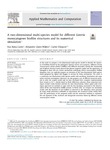A Two-Dimensional Multi-Species Model for Different Listeria Monocytogenes Biofilm Structures and Its Numerical Simulation

Ver/Abrir
Use este enlace para citar
http://hdl.handle.net/2183/25702
Excepto si se señala otra cosa, la licencia del ítem se describe como Atribución-NoComercial-SinDerivadas 4.0 Internacional
Colecciones
- Investigación (FIC) [1685]
Metadatos
Mostrar el registro completo del ítemTítulo
A Two-Dimensional Multi-Species Model for Different Listeria Monocytogenes Biofilm Structures and Its Numerical SimulationFecha
2020-11-01Cita bibliográfica
Balsa-Canto, E., López-Núñez, A., & Vázquez, C. (2020). A two-dimensional multi-species model for different Listeria monocytogenes biofilm structures and its numerical simulation. Applied Mathematics and Computation, 384, 125383.
Resumen
[Abstract] In this work we propose a two-dimensional multi-species model to describe the dynamics of biofilms formed by the pathogenic bacteria Listeria monocytogenes. Different Listeria monocytogenes strains produce biofilms with different structures, namely flat, honeycomb and clustered. Previous works showed that glucose impaired uptake and the appearance of damaged or dead cells are critical mechanisms underlying Listeria monocytogenes biofilm dynamics. Here we explicitly propose an extension of the two-dimensional multi-species model proposed by Alpkist and Klapper to account for those mechanisms. The result is a continuous two-dimensional multi-species model with non-linear detachment and mass action nutrient consumption. Moreover, we also propose a set of efficient numerical methods to solve the coupled model and we have developed their computer implementation from scratch in C/C++. Mainly based on finite differences schemes, these numerical techniques include Crank-Nicolson schemes for time discretization, Gibou’s ghost node techniques and level set methods to cope with the free boundary associated to the determination of the time-dependent biofilm domain. To finish with, we compare our simulation results with the dynamics of real biofilms as observed in the laboratory. More precisely, by using model parameters calibrated to experiments, the numerical results clearly illustrate the performance of the proposed model and the numerical methods to reproduce the real dynamics of flat, clustered and honeycomb structures shown by different Listeria monocytogenes strains.
Palabras clave
Biofilms
Continuum models
Nonlinear systems of PDEs
Finite differences
Level set methods
Continuum models
Nonlinear systems of PDEs
Finite differences
Level set methods
Versión del editor
Derechos
Atribución-NoComercial-SinDerivadas 4.0 Internacional
ISSN
0096-3003






